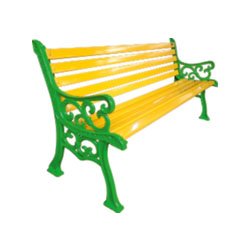An outdoor bench offers a tranquil retreat, a place to relax, read, or simply enjoy the beauty of your garden or patio. However, exposure to the elements can quickly take its toll, leaving your beloved bench faded, cracked, warped, or even completely unusable. Protecting your outdoor bench from weather damage is crucial to ensuring its longevity and maintaining its aesthetic appeal. This comprehensive guide will equip you with the knowledge and techniques to safeguard your bench, regardless of its material, location, or the climate you live in.
Understanding the Threats: Common Weather Damagers
Before diving into protection methods, it’s essential to understand the primary culprits behind outdoor bench degradation:
- Sunlight (UV Radiation): The sun’s ultraviolet (UV) rays are a major aggressor, breaking down the chemical bonds in wood, plastic, and even some metals. This leads to fading, discoloration, cracking, and embrittlement.
- Rain and Moisture: Water can seep into porous materials like wood, causing swelling, warping, rot, and mildew growth. Metal can rust and corrode when exposed to moisture. Even seemingly waterproof materials can suffer from water damage over time due to constant exposure.
- Temperature Fluctuations: Rapid changes in temperature cause materials to expand and contract. This constant cycle can lead to stress fractures, warping, and joint failure, particularly in wood.
- Snow and Ice: The weight of snow can strain the bench’s structure, while ice formation can wedge into small cracks and crevices, expanding and causing further damage as it melts and refreezes.
- Wind: Strong winds can physically damage benches, especially those made of lightweight materials. They can also carry debris like dirt, leaves, and twigs, which can scratch and abrade the surface.
- Pests: Insects like termites, carpenter ants, and wood-boring beetles can feast on wooden benches, weakening their structure.
Material Matters: Different Materials, Different Needs
The type of material your outdoor bench is made of significantly impacts its susceptibility to weather damage and, consequently, the best protection methods.
- Wood: Wood is a classic and aesthetically pleasing choice, but it’s also highly susceptible to weather damage. Softwoods like pine are more vulnerable than hardwoods like teak, cedar, or redwood.
- Teak: Naturally resistant to rot, insects, and moisture due to its high oil content. Requires minimal maintenance but can benefit from occasional cleaning and oiling to preserve its natural color.
- Cedar: Contains natural oils that make it resistant to rot and insects. Often used for outdoor furniture and requires periodic staining or sealing to maintain its appearance.
- Redwood: Similar to cedar, redwood is durable and resistant to decay. Requires similar maintenance to cedar.
- Pine: A more affordable option but requires regular treatment with preservatives, sealants, and paint to protect it from the elements.
- Metal: Metal benches, particularly those made of wrought iron or aluminum, are generally durable but can still be affected by rust and corrosion.
- Wrought Iron: Strong and heavy, but prone to rust if not properly protected. Requires regular cleaning, sanding, and painting to prevent corrosion.
- Aluminum: Lightweight and rust-resistant, making it a good choice for outdoor furniture. Powder coating provides additional protection against scratches and fading.
- Plastic and Resin: These materials are generally weather-resistant, but can still be affected by UV radiation, causing fading and embrittlement.
- Polyethylene (HDPE): Durable, weather-resistant, and recyclable. Requires minimal maintenance and can be cleaned with soap and water.
- Polypropylene: Lightweight and affordable, but less durable than HDPE. More susceptible to fading and cracking.
- Resin Wicker: Made of synthetic resin woven around a frame, offering a classic look with better weather resistance than natural wicker.
Protective Strategies: A Step-by-Step Guide
Now that you understand the threats and the materials involved, let’s explore the most effective ways to protect your outdoor bench:
- Surface Treatment and Sealing:
- Wood:
- Cleaning: Regularly clean your wooden bench with a mild soap and water solution to remove dirt, debris, and mildew.
- Sanding: Sand down any rough spots or peeling paint before applying a sealant.
- Preservative: Apply a wood preservative to protect against rot and insect infestation. Follow the manufacturer’s instructions carefully.
- Sealer or Stain: Apply a high-quality exterior wood sealant or stain to protect against moisture and UV radiation. Choose a product specifically designed for outdoor furniture. Reapply annually or as needed, depending on the product and climate.
- Oiling: For teak and other naturally oily woods, occasional oiling can help maintain their natural luster and prevent them from drying out.
- Metal:
- Cleaning: Regularly clean your metal bench with soap and water to remove dirt and grime.
- Rust Removal: If rust is present, remove it with a wire brush or sandpaper.
- Primer: Apply a rust-inhibiting primer to prevent further corrosion.
- Paint: Apply a high-quality exterior paint specifically designed for metal. Choose a color that complements your outdoor space. Reapply as needed to maintain the paint’s integrity.
- Waxing: Applying a coat of car wax can also help protect against rust.
- Plastic and Resin:
- Cleaning: Clean with soap and water to remove dirt and grime.
- UV Protectant: Apply a UV protectant spray to help prevent fading and embrittlement. Reapply regularly, especially during periods of intense sunlight.
- Covering and Storage:
- Protective Covers: Invest in a high-quality outdoor furniture cover specifically designed for benches. Choose a breathable, waterproof cover that will protect your bench from rain, snow, sun, and wind. Ensure the cover fits snugly but allows for some air circulation to prevent moisture buildup.
- Seasonal Storage: During the off-season, or during periods of prolonged inclement weather, consider storing your bench indoors in a garage, shed, or basement. This will significantly reduce its exposure to the elements and prolong its lifespan. If indoor storage is not possible, cover the bench securely and elevate it off the ground to prevent moisture from wicking up.
- Placement and Positioning:
- Sun Exposure: Consider the amount of sunlight your bench receives throughout the day. Positioning it in a shaded area can significantly reduce its exposure to UV radiation. If shade is not available, consider using an umbrella or awning to provide additional protection.
- Drainage: Ensure the area around your bench has good drainage. Avoid placing it in low-lying areas where water tends to accumulate.
- Wind Protection: If you live in an area with strong winds, position your bench in a sheltered location, such as near a fence, wall, or building. Consider anchoring the bench to the ground to prevent it from being blown over.
- Regular Maintenance and Inspection:
- Routine Cleaning: Regularly clean your bench with soap and water to remove dirt, debris, and mildew.
- Inspect for Damage: Periodically inspect your bench for signs of wear and tear, such as cracks, rust, or rot. Address any issues promptly to prevent them from worsening.
- Tighten Hardware: Check and tighten any loose screws, bolts, or other hardware.
- Reapplication of Treatments: Reapply sealants, stains, paints, or UV protectants as needed, following the manufacturer’s recommendations.
- Special Considerations for Specific Climates:
- Humid Climates: In humid environments, mildew and mold growth can be a significant problem. Use mildew-resistant cleaners and sealants. Ensure adequate ventilation around the bench to prevent moisture buildup.
- Dry Climates: In dry climates, wood can dry out and crack. Regularly oil or seal wooden benches to prevent them from drying out.
- Coastal Climates: Salt air can accelerate corrosion. Rinse metal benches regularly with fresh water to remove salt deposits.
- Cold Climates: Protect benches from snow and ice accumulation. Consider storing them indoors during the winter months.
Choosing the Right Products:
When selecting protective products for your outdoor bench, consider the following factors:
- Compatibility: Ensure the product is compatible with the material of your bench.
- Quality: Choose high-quality products from reputable brands.
- Durability: Select products that offer long-lasting protection.
- Ease of Application: Consider the ease of application and maintenance.
- Environmental Friendliness: Opt for products that are environmentally friendly and low in VOCs (volatile organic compounds).
Conclusion
Protecting your outdoor bench from weather damage requires a proactive approach and a commitment to regular maintenance. By understanding the threats, choosing the right materials, implementing protective strategies, and performing routine inspections, you can ensure that your bench remains a beautiful and functional part of your outdoor space for years to come. Remember to tailor your protection methods to the specific material of your bench and the climate you live in. With a little effort, you can enjoy your outdoor bench for many seasons to come.







